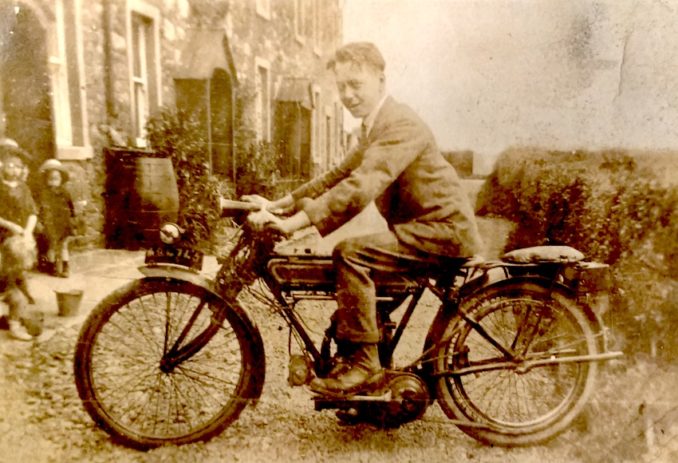
© Always Worth Saying, Going Postal 2022
No mystery here, this is Elihu, your modest reviewer of photographs grandfather. His father was also called Elihu and his grandfather was the John who Puffins with instant recall will remember lost half of the family farm on a crackpot scheme, with his nefarious 1860s ally the Duke of Northumberland, to join nowhere to nowhere with a railway line.
Later, he redeemed himself down the family iron mine. His daughter, and Elihu’s sister and the other Elihu’s aunt, was Hannah, the last of our branch of the family to farm. Our fortune further decimated by her less than prurient investment in the North British Railway.
If the name ‘Elihu’ is unfamiliar, you weren’t paying attention when you read the Bible from cover to cover. Elihu was a comforter of Job in chapters 32-37 of the Book of Job in the Old Testament. The name also gets a mention, although fleetingly, on a chapel memorial noticeable while Paster John Houston gives a fire, brimstone and harpoon sermon from a whalebone pulpit in the film Moby Dick.
Never mind all of that, what about the motorbike?
Unlike the nouveau riche mystery family of our previous Mystery Album these photographs have been captioned properly. The above is labelled ‘New Imperial 293cc 1922’ when Elihu will have been aged 16, his birth date being 16th February 1906. The registration plate is a hand-painted AO4745.
Registration numbers were introduced in 1904 and between then and 1975 motorbikes displayed theirs on a pedestrian slicing metal plate above the front wheel. Between 1904 and 1932 there was a one or two-letter code, based upon local authority area, followed by a sequenced number between 1 and 9999. From 1932 all of the area codes were two-digit. AO was for Cumberland.
To the left of the photograph is a terrace of stone-built dwellings, as if in the countryside. A water butt at the bottom of the downpipe suggests no running water. Note the stone path and erratic low hedge. The children are smartly dressed and wear shoes rather than clogs or run barefoot. Elihu is in a suit, collar and tie with proper shoes and no need for a crash helmet.
Paying similar attention to the motorbike, we can see a belt drive from the engine (rather than a chain). These would be of leather and be smooth rather than the toothed synthetic belts of the modern-day. I found an advert for a 1923 New Imperial which was similar but different, it being chain driven. Described as a 2 ¾ hp ‘Light Tourist’ it boasted a 293cc Jap engine, front and back internal expanding brakes, leg shields, three-speed gears and 26″ x 2 ¼” Avon tyres. The advert is in French and Spanish, as well as English, with the machine named as the ‘Model Number 3’ and priced at £65. Note that on my grandfather’s there are two seats with the second above the back wheel.
As for the company, New Imperial was founded by Norman Downes between 1887 and 1901, becoming New Imperial Motors Ltd in 1912. They followed the trajectory of so many companies in those days, from metalworking to manufacturing bicycle parts to whole bicycles to motorbike parts to whole motorbikes. They prospered in the 1920s but suffered in the difficult economic times of the 1930s and disappeared in a bewildering array of wartime and post-war mergers and closures.
New Imperial was incorporated as a public company in 1927. In 1928 they reported a profit of £14,824 and in 1929 a profit of £14,000. But, by 1938, the year the founder died, the Birmingham Daily Gazette was reporting the company was in receivership with the receiver, Sir C Herbert Smith accepting a takeover offer from a Mr Jack Sangster. Sangster was an industrialist and philanthropist who was to become the main man at fellow Birmingham manufacturers BSA. It was in 1956 that Sangster joined the board of BSA but in the 1930s his business interests were in Triumph and Ariel.
The following year, the Birmingham Mail reported that the New Imperial works had been bought by Clifford Motor components. During the war, aerospace components were made on the site before it was destroyed by German bombing. Post-war, the New Imperial name wasn’t resurrected by Sangster.
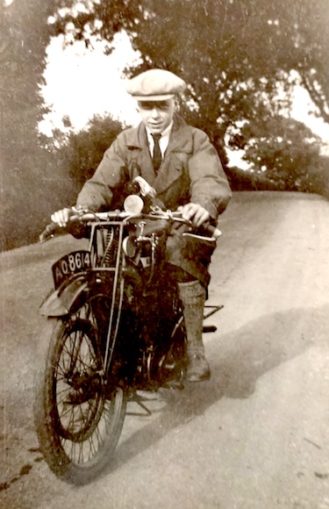
© Always Worth Saying, Going Postal 2022
Talk of BSA takes us to a 350cc 1925 model, by which time Elihu will have been a strapping country boy of 19. Googling ‘BSA 350cc 1925’ brings up the L25 which provides a good match between the above photographs and those from the contemporary BSA catalogue.
With a 3.49 horsepower engine and overhead valve arrangement, the L25 was advertised as having a ‘shock absorber’ although closer inspection suggests one big spring below the handlebars and between the front forks.

© Always Worth Saying, Going Postal 2022
Picture 3 reminds us that such new-fangled things were handy about the farm. Stronger than a horse, the motorcycle can climb steep hills, go faster for longer than anything with four legs, is more comfortable to sit on and only needs to be fed when it’s actually being used. Country types being competitive, a Cumberland County Motor Cycling Club was formed on 28th June 1910 at the Bush Hotel, Victoria Viaduct in Carlisle.
Sixteen gentlemen cyclists met to form the club. Annual subscriptions were 5/- or 25p. Their first event was an opening run to Keswick via Penrith then Bothel with tea taken at five-thirty pm at the King’s Arms Hotel, presumably the one in Wigton.
Other events included hill climbs up Kirkstone Pass, Old Firm matches versus the Westmorland Motor Club, reliability runs, petrol consumption tests and speed judging contests over mountains and around lakes where the winner was not first to finish, but the one completing the course closest to the scheduled time. Remember, in those days places like Kirksone Pass didn’t have roads through them, rather rough cart tracks. Also remember, some of the competitors will have had sidecars attached.
By 1913 membership had swelled to the point that it was possible to have a mutiny. During a six-day international road trial (ie it went the seven miles north of Carlisle into Scotland) the Carlisle Journal reported,
The competitors were so indignant at the dangerous nature of the course that they held a meeting to discuss the matter in the Great Central Hotel. About 150 riders were present.
In consequence of this decision, another mass meeting of the competitors was held, and a strike was advocated, 24 amateurs agreed to withdraw, and the trade riders telegraphed their respective firms asking for
instructions and permission to retire. The riders are unanimous in their condemnation of the use of impossible tracks in the itinerary.
Despite the Bolshevism, 109 years later the CCMCC are still at it, their next trial being February 20th 2022 at Authertree near Uldale on the B5299, only a few miles from their first tea time rendezvous in Wigton.
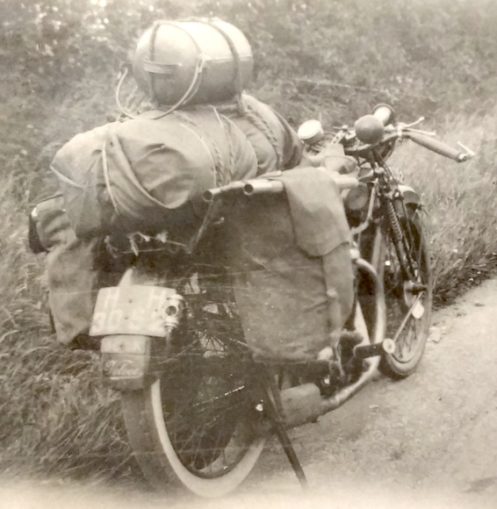
© Always Worth Saying, Going Postal 2022
Pictures 4, 5 and 6 are captioned ‘Veloce 350cc 1927’. Googling brings the Model K which is another good match.
A difference being the seat which is lowered on grandfather’s HH3052 with a second seat above the back wheel useful for camping gear or a small child. There remains no need, obviously, for crash helmets or headlights.
First introduced in 1925, by 1927 KT’s and KS’s were being built alongside a K Racer version for events such as the Isle of Mann TT races.

© Always Worth Saying, Going Postal 2022
Velocette survived the war but struggled through the 1950s not least because of the Suez fuel crisis and a troubled foray into scooter production. In the 1960s they survived by making spare parts, additionally for Royal Enfield models. By 1971 time appeared to be up, with the entire workforce being sacked, however, according to wiki,
[Survived] with C C Cooper, a local metals-recovery dealer, buying most of the machinery and continuing to produce limited spare parts by a small team of engineers. The rights to use the Velocette name and manufacture parts were then sold on to the Holder family, and the buildings at Hall Green were demolished

© Always Worth Saying, Going Postal 2022
A companies house enquiry shows THE VELOCETTE MOTOR CYCLE COMPANY LIMITED continues to this day in the hands of the Holder family and are registered as ‘Manufacturers of other parts and accessories for motor vehicles’. Based at Meriden Works, Birmingham Road, Millisons Wood, Coventry, they retail a range of parts, spares and accessories for motorbikes.
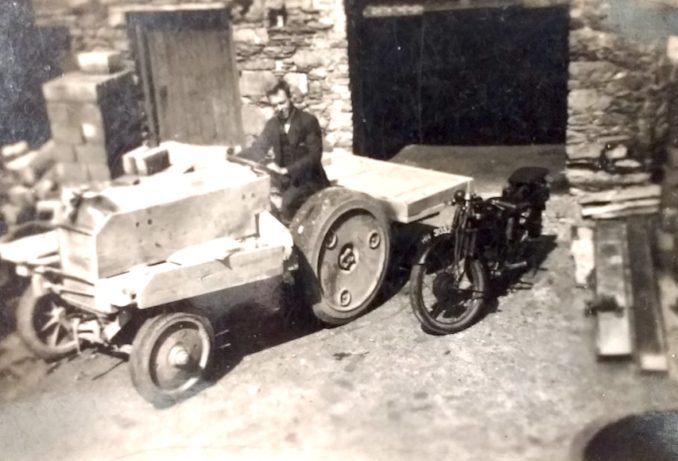
© Always Worth Saying, Going Postal 2022
As well as motorbikes, my grandfather was a dab hand with tractors. Here’s one he built himself out of wood. Note the family logo of sheep’s skull where lesser types might place a three-pointed star or Spirit of Ecstasy.
According to the album caption, underneath sits the workings of a Fordson, to the right stands the Veloce.
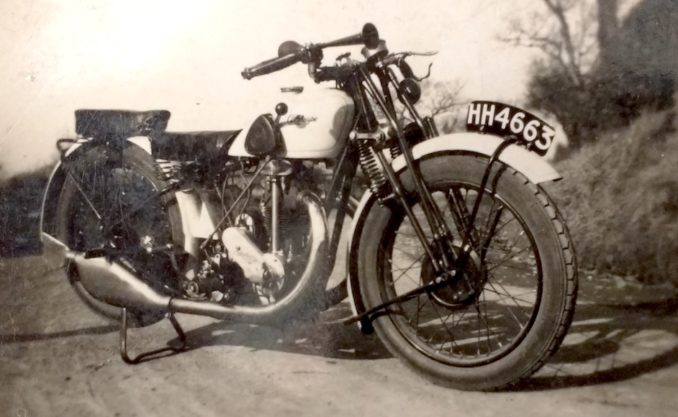
© Always Worth Saying, Going Postal 2022
They say beauty is in the eye of the beholder but if the above Calthorpe ‘industry sensation’ doesn’t catch the breath and cause the eye to linger then there’s something wrong with you. Wow. By this time, Elihu would be 23 and will have been working for about nine years. You can see where his wages went and quite right too. As building his own tractor suggests, he was employed as an agricultural mechanic. According to the Calthorpe.info website,
The Calthorpe Motor Cycle Co. was amongst the earliest makers in Birmingham and traded from 1911-1938. In the 1920s Calthorpe used Villiers as well as Blackburn and JAP engines. From 1925 onward, 350cc OHV and 500cc OHC single-cylinder models of their own manufacture were built. In 1929 they caused an industry sensation with the Ivory Calthorpe, its white tank and mudguards a departure from the then prevailing all-black colour schemes. In 1930, the Ivory was re-designed with Calthorpe’s new sloper OHV single with the oil in the crankcase. The first 350 Ivory models had a straight standing engine. The engine has a displacement of 348cc, bore 74mm / stroke 81mm.
The above photo, of HH4663, is captioned as a 1929 and does appear to have a straight standing engine. Note the gear change on the tank, the traditional horn and two shock absorbers. According to wiki, the Ivory wasn’t a great success commercially, at £52 it was expensive for the time with mass production having dropped prices since the days of the hand-built New Imperial.
By 1939 the company were in receivership with the factory’s equipment being sold and moved to Bristol. War interrupted and production was not recommenced afterwards.
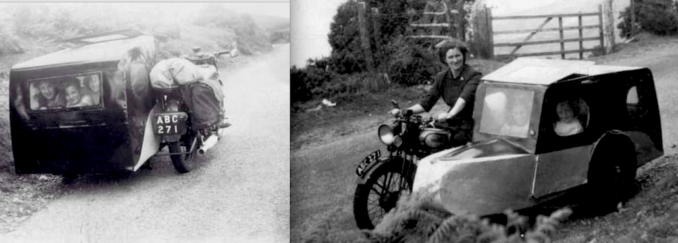
© Always Worth Saying, Going Postal 2022
While all this was going on, a neighbouring grandfather, destined to produce Mrs AWS, was busy with motorbike and homemade sidecar for six.
A remarkable generation.
© Always Worth Saying 2022



